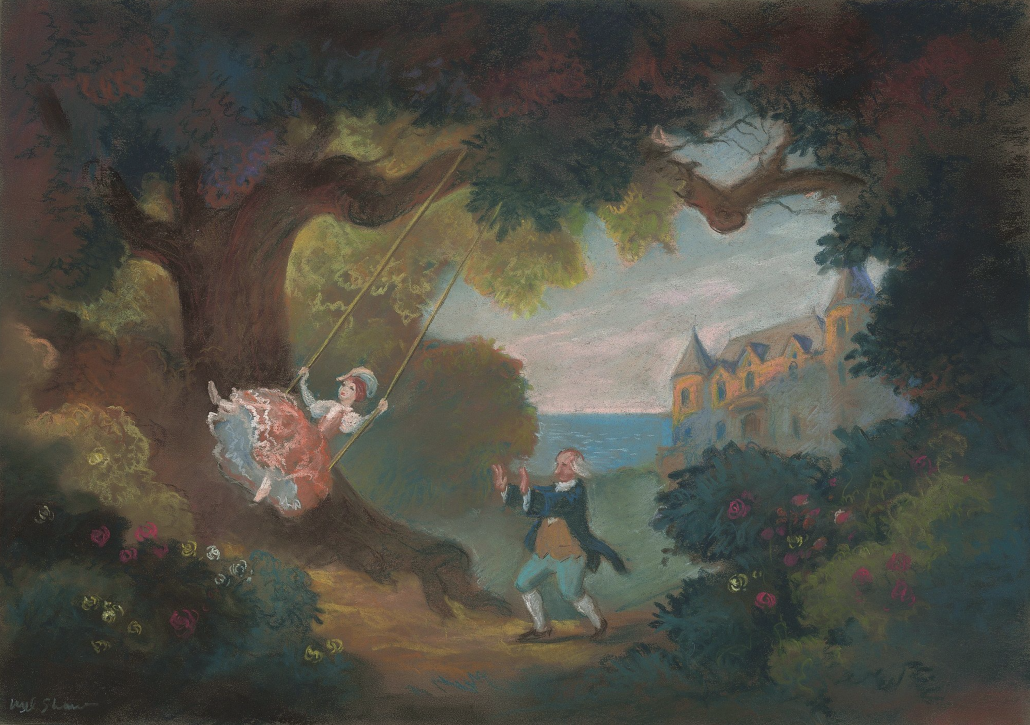Disney art at The Huntington

In 1923, soon after returning from France and World War I, Walt Disney founded his famous animation studio with his brother Roy in Los Angeles. In the decades following, their company — once confined to the space of their uncle’s garage — has grown into the cultural leviathan today known as The Walt Disney Company.
A century after the founding of the animation juggernaut, an exhibition at The Huntington seeks to explore the complex position of Disney in art history. The unmistakable aesthetic of their classic animated films and theme parks has grown (in part) from a predilection of 18th century European style. Originally curated by Wolf Burchard for the Metropolitan Museum of Art, “Inspiring Walt Disney: The Animation of French Decorative Arts” displays Disney animation pieces in concert with around 50 pieces of European decorative art, largely from the 18th century.
The exhibition features three Disney films: “Cinderella” (1950), “Sleeping Beauty” (1959), and “Beauty and the Beast” (1991), in addition to snapshots from shorter animations and the theme parks. Spanning wide chronological and stylistic ranges, this constellation of exciting art demonstrates the breadth of European influence on the Disney aesthetic.
The first two movies, “Cinderella” and “Sleeping Beauty,” come from the 1950s, a formative decade for Disney. Together, these films introduce important aspects of the animation process, while also highlighting studio artists such as the trailblazing Mary Blair. Working in a profession that, even today, is severely male-dominated, Blair broke barriers while creating iconic concept art for the studio. Famous for her striking use of color, Blair’s work garnered the attention and favor of Walt Disney and even earned comparisons with Henri Matisse.
A highlight of the exhibition is a collection of 24 hand-drawn images, together constituting the rags-to-riches transformation from “Cinderella.” Thousands of sparkles shimmer throughout the images, requiring extreme precision from the animators. The 24 frames (lasting only a second in the animation) demonstrate the detail-oriented work of Disney’s artists, even in face of the laboriousness of the work.
The exhibition’s coverage of “Beauty and the Beast” is the most expansive, and indeed, the most compelling. The film’s aesthetic harkens back to the Late Baroque/Rococo style, known for its elaborate ornamentation, asymmetrical forms and exaltation of motion. The Beast’s Castle in many ways epitomizes these forms, bearing a strong resemblance to many pieces of French architecture from this period. As Cogsworth charmingly notes during Belle’s tour of the castle: “If it’s not Baroque, don’t fix it.”
The Rococo ingredients of the film extend beyond the setting, expressed even in the portrayal of some characters. The anthropomorphic obsessions of 18th century France have clear influences on the servants of the castle, as they were enchanted into household objects. Designs for these characters are compared to corresponding pieces of decorative art: Cogsworth is accompanied by lavishly decorated clocks; Mrs. Potts and Chip are shown with richly detailed (and occasionally zoomorphic) porcelain teapots; and Lumiere stands among twisting, asymmetric candlesticks. The connections are readily apparent and endlessly captivating.
The poster children of “Inspiring Walt Disney” are undoubtedly the four Sèvres “Tower vases” — a pink pair from The Huntington’s collection and a green pair on loan from the Met. These intricately bedizened pieces of porcelain, replete with meticulous architectural detail and painted decoration, invoke the fairytale-like qualities manifested in Disneyland. Surrounded by concept art and schematic plans of “The Happiest Place on Earth,” visitors can clearly delineate the influence of Rococo decorative art on the design of the theme park.
Displaying art with such mass public appeal, “Inspiring Walt Disney’’ is designed to reach new audiences. The immersive installation constructed in the Huntington’s Boone Gallery leans into the fantasy and whimsy of the art on display.
“We’ve got music playing… we’ve got the lights really low, we’ve got the dramatic spotlighting, and we’ve got these large murals that were produced from Disney background paintings for movies,” said Dr. Melinda McCurdy, the curator of British Art at The Huntington. “So we really did work to sort of create this immersive experience, which is – maybe it’s a little Disneylandish.”
The whimsical, imagination-inducing elements of this exhibition present European decorative art in a wholly new light. “Inspiring Walt Disney” presents an entryway into appreciating a set of artistic forms and styles that might otherwise seem to lack popular appeal.
“To really get people interested in historical art, they have to have a way in. And I think things like this are a way in,” McCurdy said.
“Inspiring Walt Disney” will remain at The Huntington until March 27. Admission is discounted for students with a valid ID (or alternatively, a College Card can be purchased that allocates free admission for a year). Do not miss this unique opportunity to broaden your artistic appreciation to broaden your appreciation of Disney’s art — and the European styles lying just behind.

